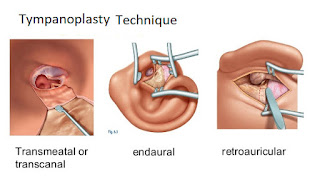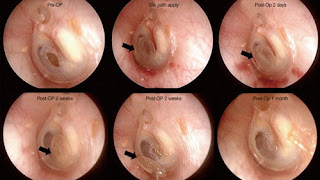What is Perforated Eardrum?
Perforated eardrum is a condition of the middle ear characterized by a hole or opening in the thin layer of tissue separating the outer ear from the middle ear.Presence of pressure in the middle ear which is greater than the atmospheric pressure in the external auditory canal may cause the tympanic membrane or the eardrum to rupture. The perforation may be caused by trauma or infection.
It may also be caused by a sudden change in atmospheric pressure such as in flying with a severe cold.
Picture 1: Perforated eardrum
image source: dreamresearchgroup.com
Perforated Eardrum Symptoms
The most common symptom of a perforated ear is pain. The pain may range from general discomfort to immediate pain or may become intense. The symptom may also vary and some of these include:- Episode of spinning sensation or known as vertigo
- Hearing changes may occur often with buzzing or clicking sound
- Drainage in the ear may appear such as fluid, blood or pus
- Hearing loss on the affected ear may occur although temporary
- Discomfort from pain which may become immediate or intense
- Uncontrollable vertigo
- Hearing changes abruptly
- Sudden loss of taste sensation or changes in taste
- Difficulty when walking
Symptoms of perforated eardrum that are complications of life-threatening complications are:
- Onset of high fever
- Numbness or tingling sensation on face, arms and legs
- Difficulty in opening the mouth especially when talking
- Sudden change in vision
- Inflammation occurring behind the ear
Perforated Eardrum Causes
Infection in the middle ear is the most common cause of perforated eardrum. Build up of fluid and pus as a result of infection may cause pressure in the ear that forces it to stretch and rupture in time.
Otitis media is one infection that causes the eardrum to rupture. Otitis media is an inflammation of the middle ear occurring in between the tympanic membrane and the inner ear.
Bacteria, virus and fungi can infect the middle ear causing the eardrum to swell which can increase the pressure in the middle ear stretching the eardrum to the limits until it ruptures.
Another common cause of perforated ear is trauma. This may include blunt trauma such as head injury or direct blow on the ear. Trauma may also include accidental puncture of the ear by sharp objects. Rapid changes in pressure can injure the ear such as deep sea diving plane flight. Barotrauma is the stress due to imbalance in pressure that can cause perforated eardrum.
There are also other possible causes that can lead to perforated eardrum such as:
Picture 2: Differences between the normal ear, some fluid and effusion
image source: kids-ent.com
Bacteria, virus and fungi can infect the middle ear causing the eardrum to swell which can increase the pressure in the middle ear stretching the eardrum to the limits until it ruptures.
Picture 3: Acute Otitis Media with Effusion
image source: otitismedia.hawkelibrary.com
There are also other possible causes that can lead to perforated eardrum such as:
- Explosive blast
- Very loud noise beyond the limit of the eardrum
- Direct slap on the ear
- Vehicular accidents
- Foreign objects that are pushed deeper into the ear
Perforated Eardrum Healing Diagnosis
Health professionals of ENT specialist can determine if there is rupture in the eardrum. Otoscope is lighted instrument utilized by most doctors in diagnosing perforated ears. Other cause of perforated ears may be evaluated by a doctor through additional test or procedures which can verify or may help determine cause of ear perforation and these tests may include:
- Tuning fork evaluation. This is a metal instrument much like a fork that produces sound when struck. This is utilized in determining hearing loss.
- Laboratory test. Discharge from the ear, if there is any, is collected and sent to the laboratory for evaluation to determine if perforation is due to bacterial infection or viral infection.
- Tympanometry. It is a device used to measure response of eardrum to light changes in air pressure. The device is inserted in the ear canal.
- Audiology exam. Measures the perception of sound at different volumes and pitches.
Perforated Eardrum Surgery
Perforation of the eardrum usually heal on its own although there are some that do not and thus require surgical intervention to promote healing and prevent infection. Surgical intervention is indicated for large holes or small non-healing holes.
Tympanoplasty is the surgical procedure for perforated eardrum. It is a procedure of repairing the tympanic membrane usually done to prevent potential infection and to improve the hearing condition of the patient.
Surgical procedure of repairing tympanic membrane is mostly successful in closing the perforation permanently and improves the hearing condition of the patient. It is usually done in the office or clinic of the doctor and is usually an outpatient basis.
Tympanoplasty is the surgical procedure for perforated eardrum. It is a procedure of repairing the tympanic membrane usually done to prevent potential infection and to improve the hearing condition of the patient.
Picture 4: Procedure of Tympanoplasty
image source: slidesharecdn.com
How long does a perforated eardrum take to heal
Most of tympanic membrane rupture heals on its own within weeks after rupture. There are some that may take up to several months. Perforation may persist due to a growing scar tissue on the edges of the perforation. Perforations that do not heal require surgical intervention.
ENT specialist or other health professionals may require eardrum patch by sealing the hole with a paper patch associated with a chemical applied on the edges of the tear to stimulate growth of tissue.
Eardrum patch procedure is usually repeated until the hole closes.
ENT specialist or other health professionals may require eardrum patch by sealing the hole with a paper patch associated with a chemical applied on the edges of the tear to stimulate growth of tissue.
Eardrum patch procedure is usually repeated until the hole closes.
Picture 5: Different stages of perforated ear drum healing pre-op and post-op
image source: www.e-sciencecentral.org
The goal of treating perforated eardrum is to alleviate the pain a patient is suffering and most importantly, preventing infection from setting in until the perforation heals on its own or through surgical means.
It is important to keep the ears dry and free from any radicals that may cause infection. Infection may further the damage or complication from perforated eardrum. It is also best to give the eardrum sometime to heal before resuming to cleaning the ears with swabs or any other form of cleaning the ears.
It is also best to seek medical advice in terms of dealing with perforated eardrum.





